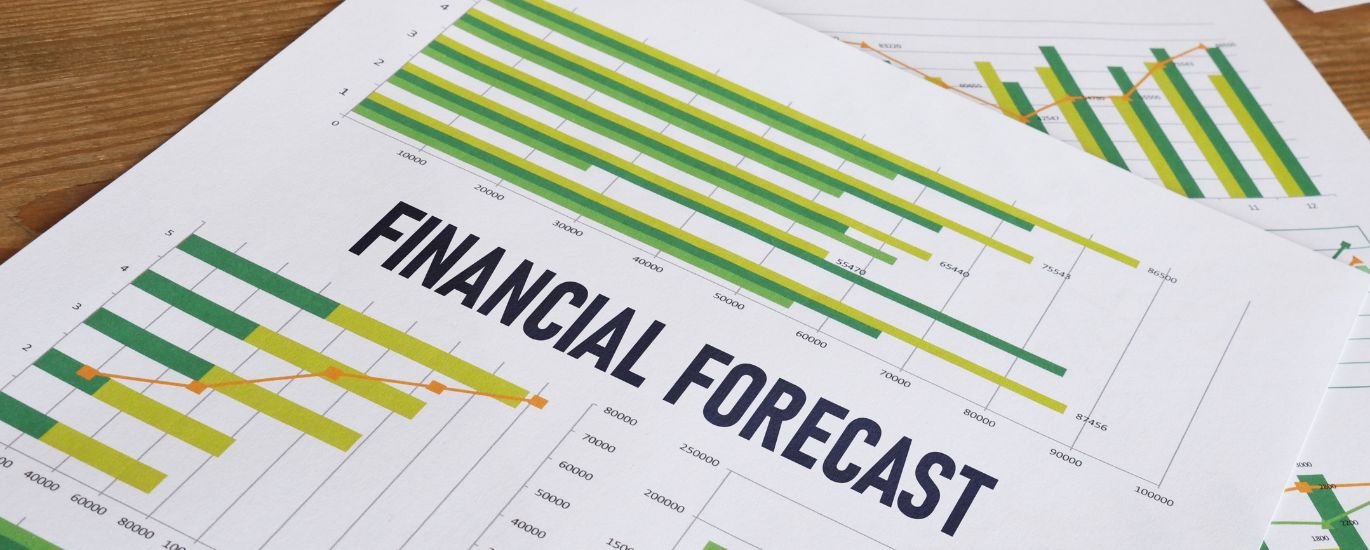Many businesses face uncertainty when it comes to planning for the future, especially without accurate financial forecasting. Without a clear picture of future financial outcomes, companies may struggle to set goals, allocate resources, or respond to market changes. This lack of foresight can lead to poor decisions, missed opportunities, and even financial instability, making it hard for businesses to grow or stay profitable.
The solution to this challenge is effective financial forecasting. By analyzing data and predicting future financial trends, businesses can make informed decisions and plan more strategically. In this blog, we will explain what financial forecasting is, how to do it, and how it plays a key role in financial planning. We’ll also discuss how financial forecasting supports the development of a strong business plan, providing you with the insights needed for long-term success.
Table of Contents
ToggleWhat is Financial Forecasting?
Financial forecasting is the process of estimating future financial outcomes based on historical data, current market trends, and anticipated changes. It involves predicting revenues, expenses, and cash flow to plan for the future. Financial forecasting aids in efficiently allocating resources, ensuring that money is spent where it’s needed most. This can include hiring new staff, purchasing inventory, or investing in marketing. Learn more about optimizing business operations through Business Process Outsourcing (BPO).
Financial forecasting uses historical data, market trends, and economic indicators to make informed predictions about a company’s future financial situation. The main goal of financial forecasting is to help businesses plan for the future. It allows them to set realistic budgets, make strategic decisions, and identify potential financial challenges.
Importance of Financial Forecasting
Financial forecasting is very important for businesses. First, it helps leaders make smart decisions about budgets and spending. By predicting future sales and costs, companies can plan better. This ensures they have enough money to cover their daily needs and invest in growth opportunities.
Second, accurate forecasts act as guides for measuring success. Businesses can compare actual results to their predictions. This helps them see what is working and what needs to change. Also, good forecasts build trust with investors and lenders. They show a clear picture of the company’s future. Overall, financial forecasting helps businesses adapt to changes and stay strong in the market.
What is the Role of Forecasting in Financial Planning?
Financial forecasting is very important for planning a business’s finances. It helps companies understand their future financial situation. By looking at past data and current trends, businesses can predict how much money they will make and spend. This information helps them make smart decisions that support their goals.
With accurate forecasts, businesses can create budgets, manage cash flow, and identify growth opportunities. Overall, financial forecasting helps companies plan for the future and stay on track with their objectives.
Key Roles of Financial Forecasting in Financial Planning

Aligning Goals with Financial Strategy
Financial forecasting allows businesses to set realistic goals and align them with their financial strategies. For instance, if a company aims to expand its operations, accurate forecasts can help determine the budget required and the timeline for achieving this goal.
Improving Decision-Making
Forecasting enhances decision-making by providing a clearer picture of future financial conditions. It enables businesses to allocate resources wisely and prepare for both best-case and worst-case scenarios.
Budgeting and Resource Allocation
Financial forecasting helps businesses estimate future income and expenses, which is essential for creating budgets. By accurately predicting cash coming in and going out, companies can use their resources wisely. This ensures that there is enough money for important operations and projects.
Goal Setting and Performance Measurement
Forecasts allow businesses to set realistic targets for income and expenses. This makes it easier to track performance against these goals. If a company is not meeting its targets, it can adjust its strategies to stay on track and achieve its financial objectives.
Risk Management
Forecasting helps identify potential risks by analyzing different scenarios that could affect financial performance. This proactive approach allows businesses to create backup plans, reducing the impact of unexpected events like economic downturns or changes in regulations.
How to Do Financial Forecasting?

Define the Purpose of Financial Forecasting
Before you begin, clarify what you want to achieve with your forecast. Are you focusing on revenue, expenses, cash flow, or overall financial performance? Understanding your goals will guide your approach and help you determine what data you need to collect.
Gather Historical Data
Collect relevant historical financial statements, such as income statements, cash flow statements, and balance sheets. This data will serve as the foundation for your projections and help you identify trends over time. If you don’t have enough historical data, consider using industry benchmarks or market research to support your estimates.
Choose a Finanacial Forecasting Method
Select a forecasting method based on the data you have and your specific needs. Common methods include:
| Category | Technique/Tool | Description |
|---|---|---|
| Quantitative | Linear Regression | Analyzes relationships between variables to predict future outcomes based on historical data. |
| Time Series Analysis | Uses historical data to identify trends and patterns for future predictions. | |
| Moving Average | Averages past data points to smooth out fluctuations and predict future values. | |
| Exponential Smoothing | Applies weighted averages of past observations, giving more weight to recent data. | |
| Percent of Sales | Projects future financial metrics as a percentage of expected sales. | |
| Financial Modeling | Creates mathematical representations of financial scenarios based on various assumptions. | |
| Business Analytics | Utilizes software to analyze large datasets for predictive insights into market trends and behaviors. | |
| Qualitative | Delphi Method | Gathers expert opinions through multiple rounds of questioning to reach a consensus forecast. |
| Market Research | Collects data on consumer preferences and market conditions to inform forecasts. | |
| Expert Opinion | Relies on insights from industry professionals to predict future performance without historical data. | |
| Scenario Planning | Develops various potential future scenarios and analyzes their impacts on the business. |
Develop Assumptions
Create realistic assumptions that will drive your forecasts. Consider factors such as market conditions, economic indicators, and internal business strategies. Document these assumptions clearly, as they will form the basis for your projections.
Create Pro Forma Financial Statements
Using the gathered data and chosen method, prepare pro forma financial statements for the forecast period. This typically includes:
- Projected Income Statement: Estimates revenues and expenses to determine net income.
- Cash Flow Statement: Projects cash inflows and outflows to assess liquidity.
- Balance Sheet: Provides a snapshot of assets, liabilities, and equity at a future date.
Monitor and Adjust
After implementing your forecast, continuously compare actual results against your projections. This monitoring helps you identify variances early and make necessary adjustments to your business strategy or forecasts.
Plan for Contingencies
Prepare for unexpected events by creating contingency plans. Consider setting aside reserves or developing alternative strategies that can be put in place if actual performance significantly deviates from your forecasts.
Tools and Techniques for Accurate Forecasting

Tools like Excel, QuickBooks, and specialized software like ForecastX and PlanGuru can streamline the process. Each tool has unique features that cater to different business needs. For more insights on optimizing your digital presence through better financial management, visit Accentor Solutions.
| Tool/Technique | Type | Description |
|---|---|---|
| Excel | Spreadsheet Software | A versatile tool for data analysis and visualization; allows for custom formulas and templates. |
| QuickBooks | Accounting Software | Automates accounting tasks, tracks income and expenses, and integrates with Excel for data management. |
| ForecastX | Specialized Software | Designed specifically for forecasting; offers advanced statistical methods and scenario analysis. |
| PlanGuru | Financial Planning Software | Provides budgeting, forecasting, and performance analysis tools; integrates with accounting software. |
Financial Forecasting for Business Plan
Why Forecasting is Crucial for a Business Plan?
A solid business plan includes financial forecasts to show potential investors that the business is viable. It offers insights into future revenue and profitability, helping investors understand the financial direction of the company. For more details, check out this article on Crafting a Powerful Online Presence.
Examples of Forecasting in Business Plans
For instance, a startup might forecast its initial cash flow, showing how long it can sustain operations before becoming profitable. This forecast can guide decisions on how much funding to seek.
Common Mistakes to Avoid in Financial Forecasting

| Common Mistake | Description |
|---|---|
| Over-reliance on Historical Data | Relying solely on past performance can lead to inaccurate forecasts, especially in rapidly changing markets. Use historical data as a foundation but incorporate current market insights and trends. |
| Ignoring External Factors | Failing to consider socio-political changes, technological advancements, or economic shifts can result in an incomplete view of the business landscape. |
| Overcomplicating the Forecasting Model | Complex models can be difficult to understand and maintain, leading to errors. Aim for simplicity by focusing on key variables that significantly impact forecasts. |
| Neglecting Regular Reviews | Treating forecasts as static documents can lead to outdated strategies. Regularly review and adjust forecasts based on new data and market conditions. |
| Underestimating Expenses | Failing to account for all operational costs and unforeseen expenses can lead to budget shortfalls. Ensure comprehensive coverage of all potential costs in your projections. |
| Relying Solely on Quantitative Data | Numbers alone do not provide a complete picture. Combine quantitative data with qualitative insights for a richer understanding of potential outcomes. |
| Lack of Cross-Departmental Collaboration | Siloed departments can result in fragmented strategies. Foster communication across teams to align forecasting efforts with overall organizational goals. |
| Focusing Only on Optimistic Scenarios | Overly optimistic projections can lead to inadequate planning for potential downturns or challenges. Utilize scenario analysis to explore best-case, worst-case, and most likely outcomes. |
| Ignoring Seasonal Variations | Overlooking cyclical trends can cause significant discrepancies between forecasts and actual results. Analyze historical data for seasonal patterns and adjust forecasts accordingly. |
| Failure to Validate Data | Inaccurate or unverified data can skew forecasts significantly. Always clean and validate your data before using it in your projections. |
Financial forecasting is an invaluable tool for strategic business planning. By predicting future trends and outcomes, businesses can make informed decisions, allocate resources efficiently, and stay ahead of market changes. Whether you’re a startup or an established company, integrating financial forecasting into your strategy can pave the way for long-term success.
Frequently Asked Questions (FAQs)
What is the main purpose of financial forecasting?
Financial forecasting aims to predict future financial performance, helping businesses make informed decisions and plan strategically.
How often should businesses update their financial forecasts?
It’s advisable to update forecasts quarterly or whenever significant changes occur in the market or within the business.
What is the difference between cash flow forecasting and revenue forecasting?
Cash flow forecasting focuses on predicting the inflow and outflow of cash, while revenue forecasting estimates future sales.
Can small businesses benefit from financial forecasting?
Absolutely! Financial forecasting helps small businesses manage their cash flow, plan for growth, and avoid potential financial pitfalls.
Where can I learn more about effective digital marketing strategies for businesses?
Check out this guide for insights on enhancing your business’s digital presence.











